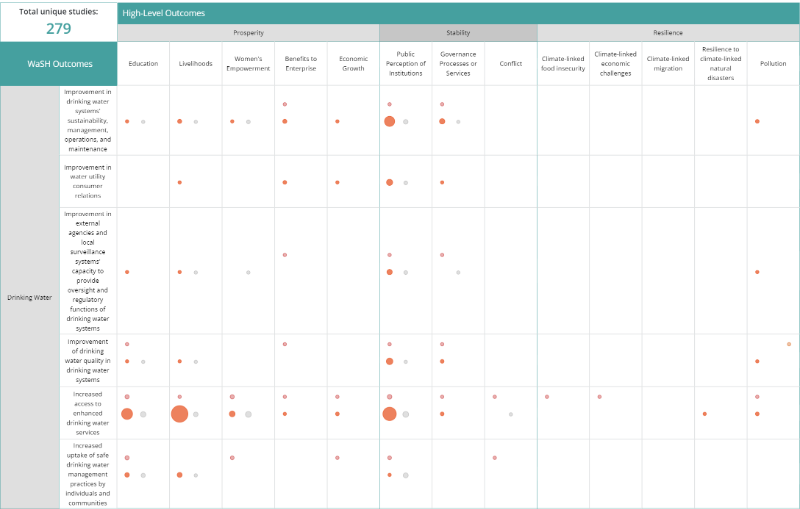- Forum
- categories
- Markets, finance and governance
- Global and regional political processes
- Sustainable Development Goals (SDGs), JMP monitoring
- Does WASH programming also contribute to additional development goals? Have a look at the findings from new systematic map
Does WASH programming also contribute to additional development goals? Have a look at the findings from new systematic map
2651 views
- sridevip
-
 Less
Less- Posts: 2
- Likes received: 1
Re: Does WASH programming also contribute to additional development goals? Have a look at the findings from new systematic map
Dear Paresh,
Thank you for your interest in our map! I'm attaching the image of our map from our systematic map from our brief (3ieimpact.org/sites/default/files/2023-0...REAPER-EGM-brief.pdf) but I encourage everyone to check out our actual map as it's interactive to allow for interaction with the studies and our filters.
We also recently hosted a webinar (youtube.com/live/4M9jSdgjMYQ?feature=share) about the map which I encourage others to check out here.
Best,
Sridevi Prasad
Thank you for your interest in our map! I'm attaching the image of our map from our systematic map from our brief (3ieimpact.org/sites/default/files/2023-0...REAPER-EGM-brief.pdf) but I encourage everyone to check out our actual map as it's interactive to allow for interaction with the studies and our filters.
We also recently hosted a webinar (youtube.com/live/4M9jSdgjMYQ?feature=share) about the map which I encourage others to check out here.
Best,
Sridevi Prasad
Attachments:
-
 Screenshot...3043.jpg
(Filesize: 73KB)
Screenshot...3043.jpg
(Filesize: 73KB)
The following user(s) like this post: paresh
Please Log in to join the conversation.
You need to login to reply- reidharvey7734
-
- I am a ceramic industrial designer focused on environmental health and development. Ceramics is ideally suited to addressing the urgent needs of low-income communities and countries. Those embracing ceramic developments will industrialize, gaining resilience and self-sufficiency.
Less- Posts: 36
- Likes received: 11
Re: Does WASH programming also contribute to additional development goals? Have a look at the findings from new systematic map
Thanks Paresh, in ceramics there is synergy in nearly all of the SDGs. This is especially true because ceramic materials are the world's most abundant. The question is, how to make use of ceramic materials.
Here again, is our presentation of October 4, 2022, to the EU Tech Chamber Manufacturing Alliance. *Industrialization from the Grassroots* is achievable by embracing the use of ceramic materials, i.e., rocks and minerals. The most sensible way to start is in trainings for production of ceramic water filters, insulating rocket stoves and sanitary toilets.
All the best,
Reid
Here again, is our presentation of October 4, 2022, to the EU Tech Chamber Manufacturing Alliance. *Industrialization from the Grassroots* is achievable by embracing the use of ceramic materials, i.e., rocks and minerals. The most sensible way to start is in trainings for production of ceramic water filters, insulating rocket stoves and sanitary toilets.
All the best,
Reid
All the best, Reid
Anthony Reid Harvey, ceramic industrial designer
Africa Prosperity Inc.
Niagara Falls, NY USA
Here is a video presentation that gives an overview of ceramic WASH and development interventions:
Harvey, Anthony Reid (2021): Sanitary stoneware toilets: production closer to the need. Loughborough University. Conference contribution. hdl.handle.net/2134/16941193.v1
Anthony Reid Harvey, ceramic industrial designer
Africa Prosperity Inc.
Niagara Falls, NY USA
Here is a video presentation that gives an overview of ceramic WASH and development interventions:
Harvey, Anthony Reid (2021): Sanitary stoneware toilets: production closer to the need. Loughborough University. Conference contribution. hdl.handle.net/2134/16941193.v1
Please Log in to join the conversation.
You need to login to reply- paresh
-

- Moderator
- Budding WASH researcher, especially interested in governance, public policy, finance, politics and social justice. Architect, Urban & Regional planner by training, Ex. C-WAS, India.I am a patient person :)
Less- Posts: 382
- Karma: 7
- Likes received: 142
Re: Does WASH programming also contribute to additional development goals? Have a look at the findings from new systematic map
Thank you Durgadas for sharing this important research. While we all probably agree that WASH interventions impact beyond the sector, this research identifies the probable impacts from the literature.
Below I copy the key findings and implications to spur discussion. I could not get the complete map as an image to add here. It would be great if you or someone more tech aware could add it to the thread.
Findings
paresh
Below I copy the key findings and implications to spur discussion. I could not get the complete map as an image to add here. It would be great if you or someone more tech aware could add it to the thread.
Findings
- Overall, we find a moderate and emerging volume of research on the associations between WaSH outcomes and accelerating prosperity, building stability, and, to a much lesser extent, enhancing resilience. However, of the 279 studies in the map, less than 18 per cent examine the link between WaSH and high-level outcomes within a causal framework.
- We found concentrations of research on increased access to enhanced drinking water services and increased access to sanitation/hygiene facilities, products or services among WaSH outcomes and on education, livelihoods, public perceptions of institutions, women’s empowerment, and pollution among high-level outcomes. We also found a concentration of research at the intersection of expansion of enabling environments for menstrual health and hygiene achievements and education, primarily focused on school absence.
- The map reveals research gaps on increased uptake of safe food hygiene practices among WaSH outcomes and on conflict and climate-linked resilience outcomes among high-level outcomes.
- We identified relatively few impact evaluations and a lack of quality systematic reviews, indicating opportunities for more causal research and high-quality synthesis work.
- This map is a useful tool for decisionmakers, development practitioners, and researchers to consult when designing theories of change, testing links between WaSH and other elements of a program’s results framework, and planning future studies. It facilitates access to a large body of research investigating WaSH associations with prosperity and stability outcomes as well as pollution outcomes within the resilience outcome domain
- The WaSH programming community should exercise caution when interpreting the contents of the map, considering that the majority of research presented is observational rather than causal.
- WaSH practitioners and researchers should partner to conduct more impact evaluations to explore the causal links between WaSH achievements and high-level outcomes. Developing this evidence could bolster the argument for investment in WaSH as not only a vital goal in its own right, but also for its effects on other development objectives.
- Researchers can fill primary research gaps by conducting food hygiene studies and examining the links between intermediate WaSH outcomes and conflict or climate-linked food insecurity, climate-linked economic challenges, climate-linked migration or resilience to climate-linked natural disasters.
- Researchers should aim to conduct higher-quality systematic reviews on WaSH outcome topics, particularly where the map reveals primary research concentrations and corresponding synthesis gaps, such as the effects of improvements in drinking water systems management on high-level outcomes or the effect of WaSH achievements on public perceptions of institutions.
paresh
Paresh Chhajed-Picha
Moderator, SuSanA forum
Project Manager at ADCPS
Indian Institute of Technology - Bombay, India
Moderator, SuSanA forum
Project Manager at ADCPS
Indian Institute of Technology - Bombay, India
Please Log in to join the conversation.
You need to login to reply- sridevip
-
 Less
Less- Posts: 2
- Likes received: 1
Re: Webinar: Does WASH programming contribute to additional development goals?
With the support of USAID, the International Initiative for Impact Evaluation (3ie) developed an
innovative outcome-to-outcome WASH systematic map
that seeks to go beyond the effects of WASH on health to understand the research base on the associations between achieving intermediate WASH outcomes and high-level development outcomes in low- and middle-income countries. The map provides an overview of nearly 300 studies that examine the linkages between achievements in drinking water, sanitation provision, and hygiene behaviours and enhanced prosperity, stability, and resilience.
In this event, we will explore the extent and characteristics of the literature on the association between selected WASH intermediate outcomes and selected prosperity, stability, and resilience outcomes in L&MICs. The panelists will also discuss reflections on the map, where additional research should be prioritized, and implications for future WASH programming.
Date: 29 June 2023
Time: 10 AM - 11 AM EST
Register to join !
Map | Report | Brief | Protocol
In this event, we will explore the extent and characteristics of the literature on the association between selected WASH intermediate outcomes and selected prosperity, stability, and resilience outcomes in L&MICs. The panelists will also discuss reflections on the map, where additional research should be prioritized, and implications for future WASH programming.
Date: 29 June 2023
Time: 10 AM - 11 AM EST
Register to join !
Map | Report | Brief | Protocol
Attachments:
-
 WaSHmapsubset.png
(Filesize: 73KB)
WaSHmapsubset.png
(Filesize: 73KB)
Please Log in to join the conversation.
You need to login to reply- Durgadasmenon
-
Topic Author
- User
Less- Likes received: 1
Does WASH programming also contribute to additional development goals? Have a look at the findings from new systematic map
Dear all, Does WASH programming contribute to additional development goals like education, economic growth, or women?s empowerment?
To answer this question, with the support of USAID, 3ie developed an* innovative new WASH systematic map <developmentevidence.3ieimpact.org/egm/re...ash-evidence-gap-map>* that explores the value of water security investments for the broader development ecosystem. The map provides an overview of nearly 300 studies that examine the linkages between achievements in drinking water, sanitation provision, and hygiene behaviours and enhanced prosperity, stability, and resilience. The map itself does not provide definitive answers to these questions but points the user towards studies that address the relationships.
Read more in this blog: www.3ieimpact.org/blogs/mapping-big-pict...el-development-goals Best wishes, Durgadas, 3ie
-- Durgadas Menon Manager, online communication and marketing International Initiative for Impact Evaluation (3ie) Follow us on Twitter <twitter.com/3ieNews> | LinkedIn <www.linkedin.com/company/3ieimpact> | Facebook <www.facebook.com/3ieimpact> | Subscribe to 3ie <www.3ieimpact.org/Join-3ie-mailing-list>
--
Blog |
To answer this question, with the support of USAID, 3ie developed an* innovative new WASH systematic map <developmentevidence.3ieimpact.org/egm/re...ash-evidence-gap-map>* that explores the value of water security investments for the broader development ecosystem. The map provides an overview of nearly 300 studies that examine the linkages between achievements in drinking water, sanitation provision, and hygiene behaviours and enhanced prosperity, stability, and resilience. The map itself does not provide definitive answers to these questions but points the user towards studies that address the relationships.
Read more in this blog: www.3ieimpact.org/blogs/mapping-big-pict...el-development-goals Best wishes, Durgadas, 3ie
-- Durgadas Menon Manager, online communication and marketing International Initiative for Impact Evaluation (3ie) Follow us on Twitter <twitter.com/3ieNews> | LinkedIn <www.linkedin.com/company/3ieimpact> | Facebook <www.facebook.com/3ieimpact> | Subscribe to 3ie <www.3ieimpact.org/Join-3ie-mailing-list>
--
Blog |
The following user(s) like this post: jnjagi
Please Log in to join the conversation.
You need to login to reply
Share this thread:
- Forum
- categories
- Markets, finance and governance
- Global and regional political processes
- Sustainable Development Goals (SDGs), JMP monitoring
- Does WASH programming also contribute to additional development goals? Have a look at the findings from new systematic map
Recently active users. Who else has been active?
Time to create page: 0.131 seconds







